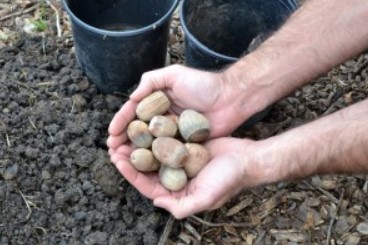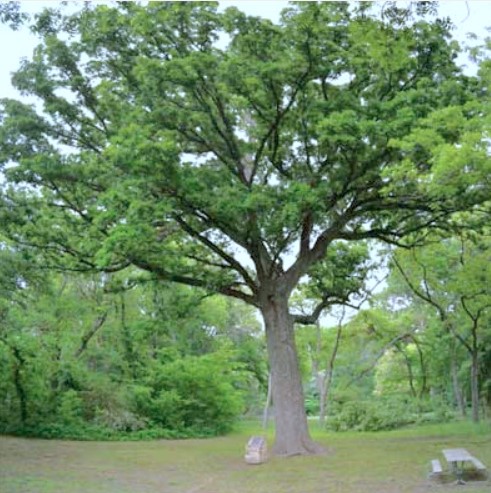
Tree Species Profiles: Top Rated Shade Trees, Bur Oak (Quercus macrocarpa)

Bur Oaks get their common name from the shaggy, fringed caps that contain the acorn. All photos by Bill Seaman.

Published April 19, 2013, By STEVE HOUSER
When French botanist André Michaux (1746-1802) garnered the botanical naming rights for Bur Oaks, he went for the obvious: Quercus macrocarpa, the Oak with the large fruit. Even his description is a bit of an understatement considering this Oak can grow to exceed 80 feet in height, have leaves longer than 10 inches, and grow acorns the size of lemons. Bur Oak, which is also known as Mossycup Oak and is sometimes spelled with an extra “r,” gets its common name from the distinctively rough and shaggy acorn cap that can often enclose much of the acorn itself. The acorns are a highly desirable food source for wildlife, but their size alone provides a challenge for squirrels anxious to dig a hole large enough to bury them or to find the strength to hoist them to their cache. To a squirrel or other wildlife, Bur Oak acorns are like a huge steak dinner.
With a native range that stretches from the Texas Coastal Plains to Manitoba, Bur Oaks are adapted to most Texas landscapes. In North Central Texas, they can be found growing in the rich-soil bottomlands along creeks and rivers, where moisture is available during periods of drought. One of the state’s largest Bur Oaks grows along Rowlett Creek in Plano’s Bob Woodruff Park. Recognized as a Bicentennial Tree in 1976, this landmark is believed to be more than 400 years old, and requires at least four children to give it a hand-in-hand hug. Remember what it was like to be a barefoot little tree hugger?

A little “tree hugger” at the Bicentennial Bur Oak in Plano’s Bob Woodruff Park.
Bur Oaks are a relative newcomer to the retail nursery trade in Texas. Few trees were grown commercially before 1980. Many Bur Oaks planted in landscapes and gardens before that time were homegrown by industrious gardeners who had access to the easily germinated acorns and were eager to pass them along to other gardeners. Bur Oak acorns require no cooling period to sprout, so acorns gathered in the fall can be planted in containers immediately. They grow fast enough to transplant into the garden the following year.

Bur Oak acorns are easy to plant and will germinate in a few weeks. They can be transplanted into the yard the following fall.
Bur Oaks have a number of characteristics that gardeners can appreciate. First, the tree has a moderate growth rate. Once fully established, a well-cared-for tree can generate more than 20 inches of shade-producing growth a year. As the tree ages, the stout limbs are resistant to wind and ice damage, and the corky bark protects it from sunscald as well as fire, to some degree. Our hottest Texas summers pose no challenge to its drought tolerance. While Bur Oaks are not known for fall color, occasionally they delight us with a golden display before leaf drop reveals a coarse and rugged winter branching form. Strong wood and a tendency to grow some horizontal lower branches can make bur oaks good climbing trees and great candidates for swings. What may be the most valuable trait is their resistance to Oak Wilt, making them a good Oak substitution or replacement for often over-planted Live Oaks and Red Oaks.

The Bicentennial Bur Oak is thought to be more than 400 years old.
Bur Oaks are suitable trees for large urban landscapes, since the canopy widths can exceed 75 feet as they mature. Keep the mature size in mind when determining the proper location for planting, avoiding future conflicts with structures, as well as utility lines. Bur Oaks can be planted to shade sidewalks, driveways, and patios. Even though the acorns can be both large and prolific, they are manageable. Some years, the squirrel patrol will be happy to manage them for you.
Native to much of Texas and adapted to more, the Bur Oak ranks high on almost all top shade tree lists. Plant them knowing they will be enjoyed for the next 100 years. Future generations of children (as well as squirrels) will be eternally grateful!
To continue reading the Top Rated Trees article series, please click here.

